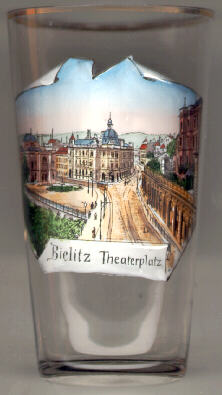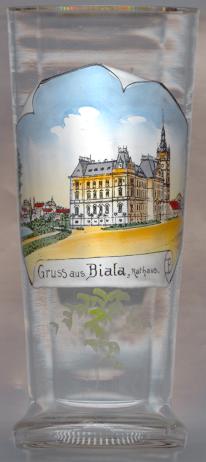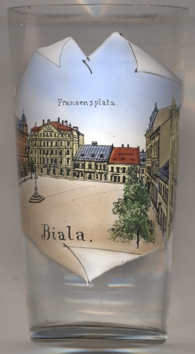

|
| POLSKA | POLAND |
| województwo: Śląskie | voivodship: Silesia |
| miasto na prawach powiatu: Bielsko-Biała | city: Bielsko-Biała |
Bielsko-Biała is situated at the Biała river, tributary of the river Wisła (Weichsel, Vistula) in the Beskidy mountains near the border to the Czech Republic and to Slovakia. The river formed the border between the old duchies of Cieszyn (Teschen) and Oświęcim (Auschwitz), later between the Duchy of Silesia and the Kingdom of Galicia and Lodomeria within the Austrian monarchy. The administration of Bielsko (Bielitz) and Biała (Biala) was combined first in 1939.The two towns were finally merged in 1951.

Bielsko (Bielitz) on the left bank of the river Biała was founded during the 13th century and in 1312 was first mentioned as a town.
The Piast duchy of Cieszyn (Teschen) came in possession of the Bohemian crown in 1327. In 1442 it became an independent
territory at the border between Poland and the Austrian countries. Since the Middle Ages Bielsko has been a centre of clothmaking.
In 1545 the town converted to the Protestant faith. It was the only town in Austria that did not return to catholicism during the Counter-Reformation and
remained the only Protestant town in Austria until 1742. In 1753 the territory of Bielitz/Bielsko became a principality and in 1754 a duchy belonging to the
Sułkowski family. After World War I, Bielsko became part of Poland in 1920. During the early 20th century, Bielsko was the second-largest
centre of textile industry in Poland after Łódź.
The  castle [left, no. 295: far right] of the Sułkowski family goes back to a castle that was built by the
dukes of Cieszyn (Teschen) in the second half of the 14th century. It was later enlarged in the 15th to 17th century. It finally received its present appearance
between 1855 and 1864 when it was remodelled in eclectic style. The castle ermained in possession of the Sułkowskis until 1945. Today it houses
the regional museum.
castle [left, no. 295: far right] of the Sułkowski family goes back to a castle that was built by the
dukes of Cieszyn (Teschen) in the second half of the 14th century. It was later enlarged in the 15th to 17th century. It finally received its present appearance
between 1855 and 1864 when it was remodelled in eclectic style. The castle ermained in possession of the Sułkowskis until 1945. Today it houses
the regional museum.
The  Municipal Theatre (now Teatr Polski) [left, no. 295: far left] was built in 1888–1890 by
the architect Emil Förster in Neo-Classicist style.
Municipal Theatre (now Teatr Polski) [left, no. 295: far left] was built in 1888–1890 by
the architect Emil Förster in Neo-Classicist style.


Biała (Biala) on the right bank of the river was part of the duchy of Oświęcim (Auschwitz) until the duchy became part of Poland in the 15th century.
Biała was chartered as a town in 1723. After the 1st Partition of Poland in 1772 Biała became part of the Austrian Kingdom of Galicia and Lodomeria.
It it became part of Poland again after World War I in 1918.
The  town hall [left, no. 696] of Biała (today of Bielsko-Biała) was built in 1895–1890 by
the architect Emanuel Rost in Neo-Renaissance style.
town hall [left, no. 696] of Biała (today of Bielsko-Biała) was built in 1895–1890 by
the architect Emanuel Rost in Neo-Renaissance style.
Glass no. 4005 [right] shows a view of the square  Plac Wolności
Plac Wolności Hotel
Hotel
[https://pl.m.wikipedia.org/wiki/Hotel_Pod_Orlem_w_Bielsku-Bialej]
![[scale]](lineal.jpg)